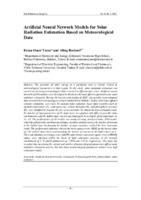Artificial Neural Network Models for Solar Radiation Estimation Based on Meteorological Data

Megtekintés/
Metaadat
Teljes megjelenítés
Link a dokumentumra való hivatkozáshoz:
Gyűjtemény
Absztrakt
The presence of solar energy in a particular area is closely related to
meteorological parameters in that region. In this study, solar radiation estimation was
carried out by using meteorological data recorded in different time series. Artificial neural
networks (ANN) models were developed to determine the most effective parameters for solar
radiation estimation. During the training and testing of ANN, site-specific meteorological
data recorded by a meteorological station established in Hakkâri, Turkey, which has difficult
climatic conditions, were used. To estimate solar radiation, basic input variables such as
ambient temperature (T), wind speed (w), relative humidity (H), and atmospheric pressure
(P), were modified by keeping the time series constant. To obtain the best estimation result,
the number of input parameters of the input layer was applied with different possible input
combinations, and the hidden layer neuron was changed to be multiples of the input layer (n,
2n, n²). The performance of all models was analyzed using statistical tools. ANN model,
which has all possible combinations of input variables and determines the number of neurons
in the hidden layer by framing the number of input variables, yielded the best estimation
result. The performance indicator showed the mean square error (MSE) as the lowest value
of 2.56 with all data entries and modeling the number of neurons in the hidden layer as n2.
The mean absolute percentage error (MAPE) and relative root mean square error (rRMSE)
values were obtained within the limits of high estimation accuracy in the network
combination of T, P and H parameters as 1.99% and 1.91%, respectively. This study has
revealed that increasing the variety and number of meteorological parameters affects solar
radiation estimation success, but only basic meteorological parameters achieve very high
estimation results.
- Cím és alcím
- Artificial Neural Network Models for Solar Radiation Estimation Based on Meteorological Data
- Szerző
- Yuzer, Ersan Omer
- Bozkurt, Altug
- Megjelenés ideje
- 2025
- Hozzáférés szintje
- Open access
- ISSN, e-ISSN
- 1785-8860
- Nyelv
- en
- Terjedelem
- 23 p.
- Tárgyszó
- artificial neural networks, estimation, meteorological data, photovoltaic, solar radiation
- Változat
- Kiadói változat
- Egyéb azonosítók
- DOI: 10.12700/APH.22.1.2025.1.3
- A cikket/könyvrészletet tartalmazó dokumentum címe
- Acta Polytechnica Hungarica
- A forrás folyóirat éve
- 2025
- A forrás folyóirat évfolyama
- 22. évf.
- A forrás folyóirat száma
- 1. sz.
- Műfaj
- Tudományos cikk
- Tudományterület
- Műszaki tudományok - multidiszciplináris műszaki tudományok
- Egyetem
- Óbudai Egyetem
